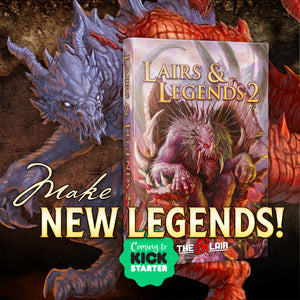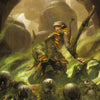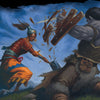Group Patrons in D&D: What They Are, Why They’re Awesome, and How to Use Them

By Luke Hart
Today in the Lair, we’re diving into group patrons—what they are, why you should consider using them in your games, and how to put them into play at your table.
Yes, Tasha’s Cauldron of Everything introduced group patrons, and the Eberron campaign setting book has them as well. Personally, I think the Eberron version is better—it feels more flavorful and tied to the world—but Tasha’s has the advantage of being system-neutral and applicable to any setting. Either way, group patrons are a powerful tool for both DMs and players, and they can really enhance the way a campaign runs.
So let’s get into it: what exactly is a group patron, why should you use one, and how do you run it effectively?
By the way, if you need a quick adventure to run for your group when you're in a pinch, check out all the one-shots we have to choose from. Grab an adventure, read it in about 15 minutes, and you’re ready to run your game!
Watch or listen to this article by clicking the video below.
What Is a Group Patron?
At its core, a group patron is a powerful individual or organization who sponsors the adventuring party.
That sponsorship comes with privileges, perks, and resources the characters can draw upon—but it also comes with responsibilities. Patrons expect the adventuring party to perform missions or tasks in exchange for those benefits.
For example:
- If the party’s patron is an espionage agency, the characters might have access to expense accounts, forged papers, and powerful contacts. But in return, they’ll be asked to infiltrate noble houses, intercept caravans, and dig up dirt on influential rivals.
- If the patron is the City Guard, the party might receive official papers marking them as agents of the law, the authority to enter residences without warrants, and flexibility when dealing with criminals. But their jobs will involve hunting down serial killers, investigating rumors of wererats in the sewers, and generally keeping the peace.
In other words, a patron isn’t just a benefactor—it’s an engine for both resources and story direction.
Advantages of Using Group Patrons
So why bother with group patrons? Because they make the DM’s life easier, solve common problems at the table, and give your players structure and direction.
1. Provides a Built-In Quest Hub
Every DM needs ways to deliver adventure hooks. Sometimes it’s through rumors or chance encounters, but often it’s directly from NPCs. A patron provides a natural, expected quest giver.
Because the players chose the patron, they expect to receive missions from them. No awkwardness, no “why would we trust this random NPC?”—it’s just part of the arrangement. That makes dropping adventures into your game smooth and simple.
2. Solves the “Players Refuse Adventures” Problem
One of the most reported frustrations among DMs is prepping an adventure… and then having the players ignore it.
Group patrons fix that. When players agree to work with a patron, they’re essentially saying: “Yes, we’re on board with being sent on missions.” There’s player buy-in from the start, which means they’re much more likely to follow the hooks you put out.
It’s psychology: when players make the choice, they feel ownership of it. And if they blow off the patron, they lose the perks they signed up for—so they have a strong incentive to honor the deal.
3. Keeps the Group Together
We’ve all had that one player who wants to wander off constantly. Suddenly you’re running two different games at once, which is frustrating for everyone.
Group patrons give the party a shared reason to stick together. Since their benefits come as a group, it reinforces cohesion and encourages players to work toward a common cause.
4. Gives Direction to New Players
New players often don’t recognize hooks or understand the social contract of the game. They may just wander, get distracted, or fail to grasp what they’re supposed to be doing.
A patron cuts through that confusion. “Go do X, and you’ll be rewarded with Y” is clear, straightforward, and helpful. It’s training wheels for learning the game while still being fun and immersive.
5. Supports the Main Plotline
Patrons can directly tie into your campaign’s central story.
If your patron is the City Guard, and the campaign revolves around dismantling the Shadow Thieves, then missions naturally align with that plot: raid a thieves’ den, capture lieutenants, dismantle smuggling operations. Over time, those missions build toward the larger conflict.
6. Adds Variety
On the flip side, patrons are also a tool for variety. If you and your players need a break from the main storyline, the patron can hand out unrelated missions.
This can spark new ideas for side quests or even ignite inspiration for your campaign’s next big arc. Maybe a random mission the patron offers becomes the seed for your main story.
How to Use a Group Patron
Now that we know why patrons are awesome, let’s talk about how to actually use them in your game.
1. What Makes a Good Patron?
A good patron is more powerful or wealthy than the adventurers. They must have the means to support the group and the motives to make use of them.
- Good patrons. Dragonmarked Houses, wealthy nobles, criminal syndicates, the City Guard.
- Bad patrons. A poor beggar with no resources (they might be a quest giver, but not a patron).
Also, patrons need points of contact—NPCs who can interact with the party, deliver missions, and reward them.
2. How to Introduce a Patron
There are two main ways:
- At Session Zero. Present players with patron options, let them choose, and build the campaign around that choice. Their decision sets the tone for the campaign.
- Mid-Campaign. As the characters gain renown, potential patrons reach out, offering perks and requesting service. The group then decides whether to align with one.
While the DM can pick the patron, I recommend letting the players choose—it gives them more investment in the game.
3. Patrons as Quest Hubs
When delivering missions, you can handle it in different ways:
- Directive. The patron expects the mission to be completed. Great for new players who need guidance.
- Optional. Missions are requests, not orders. Works well with experienced players who value agency.
The sweet spot? A mix of both. Some missions are non-negotiable, others are optional.
4. Benefits and Perks
The perks are what make patrons attractive. There are two main types:
- Standing benefits. Always active. For example, a Dragonmarked House might provide pay (10 gp × level per day of work), discounts on services, or free travel papers.
- Mission rewards. Payment, magic items, or favors after a job is done. You can even use a favor system—complete more missions, get better standing benefits.
5. Losing Patronage
If the group consistently ignores or betrays their patron, expect consequences. Benefits dry up, ties are severed, and in some cases—like criminal organizations—they might even put a bounty on the adventurers’ heads.
Easy-to-Prep One-Shot Adventures
Whether you're too busy to prep an adventure and game night is fast approaching or you'd just rather use a professional pre-made adventure for your group, our 5e and PF2e one-shot adventures have you covered.
- Dozens of adventures, all levels of play
- Lightning fast to prep
- Read-a-loud text, NPCs, area descriptions, roleplaying notes, encounter notes
- Digital maps (GM and player versions, gridded and un-gridded)
- Everything you need to play!
Gone are the days of just winging it and hoping for the best. Check out everything our one-shot adventures have to offer today!
-
Posted in
Game Master How-To Articles







